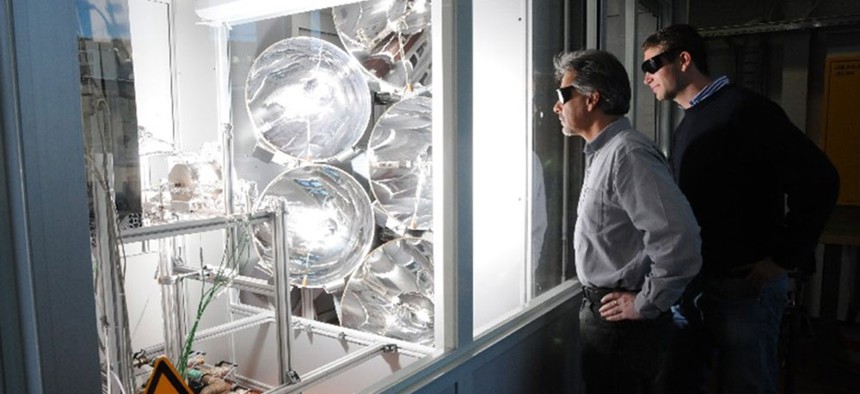
Two men looking at the Solar Jet reactor at work Solar Jet Aero
Future Planes Could Run on Fuel Made from Sunlight
Researchers concentrate sunlight to make solar kerosene. By Patrick Tucker
The cost of fuel is no small barrier to running the world's largest military. Among the alternative options, solar power just doesn't provide the energy density or the reliability for heavy, high-energy demand performance machines. But that doesn't mean you can't run an F-35 off of sunlight, in a way.
A group of European researchers with the Solar-Jet program have demonstrated a process for turning concentrated sunlight, water and CO 2 into a kerosene that can power ships, jets, and virtually anything that uses a combustion engine. Because the CO 2 that went into the kerosene is derived from the air, and not from fossil sources, the fuel is effectively carbon neutral. The researchers say it's nine times as efficient as many biofuels.
Here's how the process works: take a metal oxide ceramic material called ceria and remove most of the oxygen, bringing the material to what's called an oxygen deficient state. Then expose it to heat at 700 degrees Celsius; introduce water vapor and CO 2 . After the chemical reaction, what you get is a synthetic gas of hydrogen and carbon monoxide, which can then be converted to kerosene. The hard part is getting to those high temperatures with sunlight, since achieving that level of heat requires a lot of energy. The researchers in this case used a reactor that concentrates sunlight to achieve super high levels of heat. Swiss researcher Aldo Steinfeld led the team that designed it.
"What we are doing here is we are reversing the combustion process," Andreas Sizmann of the Bauhaus-Luftfahr research group, which is affiliated with the program, told Defense One . "When [kerosene] is put in the tank and the engine starts, the engine takes oxygen from the air, burns the fuel, and makes water vapor and CO 2 ."
The sunlight kerosene is usable today but won't be economically viable for perhaps another 10 years Sizmann said. "First we have to scale up the size of the reactor, then we have to improve the efficiency of the material, and third, we have to do more research on heat management in order to make the best use of the high temperature heat," he said. He believes that if the researchers can achieve those steps, they should be able to reach an energy efficiency rate of 15 percent to perhaps even 20 percent, where 20 percent of the solar energy striking the surface of the solar panels feeding the reactor is converted directly into fuel.
"Conventional fuel is energy that you just take from the ground, so you have to put in very little energy in the process, but for any renewable fuel that goes through a closed cycle, you have to put all the energy in that you get out of the heating value of the fuel. So you need at least a certain factor of energy input just to create a heating value and then more energy to compensate for energy losses in the process. In the end, even though our process is very efficient, it's the cost of the fuel that makes it competitive on the market or not," Sizmann said.
At the 20 percent efficiency level, the sunlight gas could compete with oil priced at $200 per barrel. That may not sound like a dramatic improvement until you consider that the availability of oil is what determines the cost, not the harm that fossil fuels do the climate or the role that they play in propping up nondemocratic regimes. The sunlight fuel provides a clear advantage over other types of biofuels, such as corn-based ethanol, since it wouldn't compete with usable farmland, just flat and dry desert. "We found our process can be nine times as efficient as bio to liquid," said Sizmann.
Recently, the Navy announced that they had successfully turned seawater into fuel . Sizmann sees the Solar-Jet kerosene as a complimentary product, not direct competition. "For [the Navy], it's security of supply. We're addressing a future problem of sustainability for aviation and mobility as a whole. We're looking at the substation of fossil kerosene at a large scale and its economic viability," he said.
NEXT STORY: Why Ukraine Has Already Lost The Cyberwar, Too




